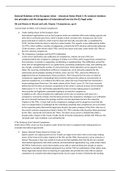Resume
Summary External Relations of the European Union - Literature Summaries week 3
- Cours
- Établissement
Summaries of the readings for External Relations of the European Union week 3: - Ott and Matera in Wessel and Larik, Chapter 3 Competences, pp.61; - Wessel in Wessel and Larik, Chapter 5 The EU and International law, (pp 139-171); - Ott and Matera in Wessel and Larik, Chapter 12 The external dimens...
[Montrer plus]



